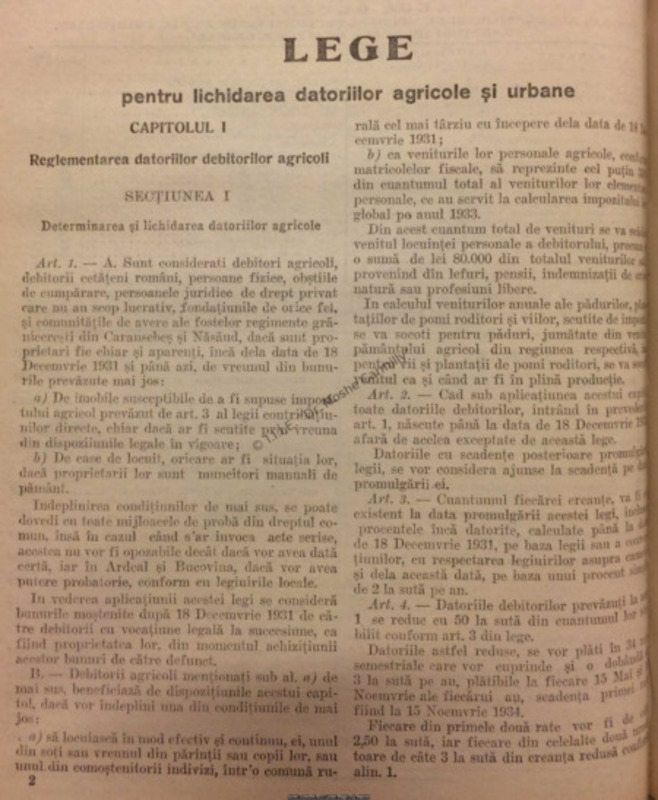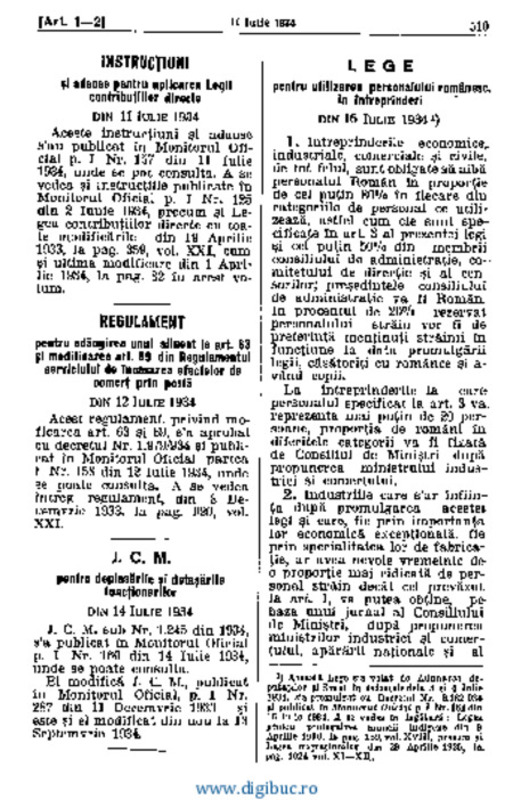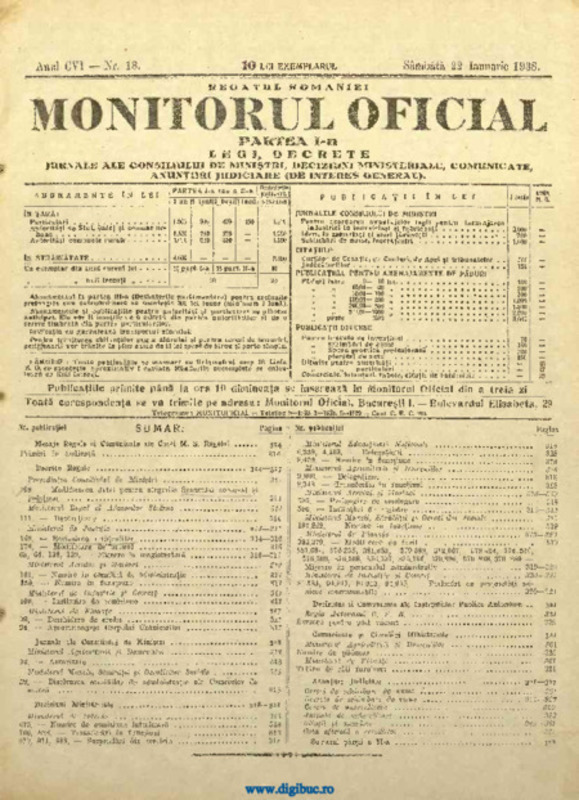Anti-Jewish legislation in Romania (January 1934-30 August 1940)
The Jewish population of northern Transylvania was deeply affected by the enactment of anti-Jewish legislation during the Romanian administration, as well as after the Second Vienna Award of 30 August 1940, when northern Transylvania was annexed to Hungary.
Anti-Jewish legislation in Romania (January 1934-30 August 1940)
The first stages of anti-Jewish legislation occurred during the interwar period, when Romanian Jews (including those in northern Transylvania) were the direct target of this type of legislation which restricted, and then abolished, their fundamental civil rights, laying the ground for the future deportation and annihilation of the Jews. During the interwar period, several far-right parties emerged in Romania which contributed to a further radicalisation of the fascist and anti-Semitic political discourse. The parties whose ideological platform was based on an extremist, xenophobic and anti-Semitic discourse were: Liga Apărării Naţional Creştine – LANC (The National-Christian Defense League), led by A.C. Cuza, and Legiunea Arhanghelului Mihail (the Legion of the Archangel Michael), founded in 1927 by Corneliu Zelea Codreanu, and which developed into the Garda de Fier (Iron Guard) in 1930. Destroyed in 1933 by the liberal government led by I. G. Duca, the Iron Guard re-emerged as the Totul pentru Ţară (Everything for the Country) Party, gaining 15.56% of the votes in the 1937 election.
The laws of the Tătărescu Government (January 1934-December 1937)
The first stage of the anti-Jewish policy promoted at state level resulted in laws that were not explicitly directed at the Jewish population, but which, by their provisions, held a discriminatory character that affected the Jewish citizens of Romania. These discriminatory laws were passed during Gheorghe Tătărescu’s Government (January 1934-December 1937):

The Official Gazette of Romania, 7 April 1934
The law for the settlement of agricultural and urban debt (7 April 1934)
1. The law for the settlement of agricultural and urban debt (7 April 1934)
Through the implementation of these provisions, the Romanian Jewish citizens who were creditors saw their wealth reduced by 20-70%, and they had to wait to collect what they were owed. At the same time, the Romanian Jewish citizens who were debtors had to immediately pay the full debt.
2. The law for the employment of Romanians in enterprises (16 July 1934)
The first article of this law stipulates that at least 80% of employees of all businesses in Romania and at least 50% of their board members had to be Romanian. In addition, the chairmen of the boards of directors had to be Romanian, as well. Regarding the 20% reserved for foreign staff, foreigners with Romanian wives and children were given priority.
The laws and orders of the Goga-Cuza Government (29 December 1937-10 February 1938) and from the period of royal dictatorship (10 February 1938-5 September 1940)
The second stage of the anti-Jewish policy promoted at state level resulted in explicitly anti-Jewish government orders and laws whose implementation was aimed at depriving the Jewish population of all its civil rights.
a. Government orders
- The ban on newspapers edited by Jewish journalists, including Dimineaţa (Morning), Adeverul (The Truth), Lupta (The Struggle), Lumea (The World), Noutatea (The News), Czernowitzer Blaetter (The Chernivtsi Gazette), Darkenu (Our Path), Dos Yidishe Vort (The Jewish Word).
- The withdrawal of the permit for free movement on the Romanian railways from Jewish journalists.
- The exclusion of Jews from all departments of public administration. This government provision resulted in lists of names of Jewish civil servants, doctors and lawyers (who worked in various sectors of the public administration) and their dismissal. Another consequence of this order was that 1540 Jewish lawyers from the Bucharest Bar Association were excluded from this professional organisation.
- The exclusion of Jews from the selling of products which were under state-monopoly (tobacco, alcohol, matches), and from agricultural trade.
- The exclusion of enterprises employing Jewish staff in which the state was one of the parties involved (either as customer or supplier).
- The expropriation of agricultural enterprises, real estate and properties owned by Jews or Jewish institutions, for “the benefit of the public interest”.
- The expulsion of rabbis who were not Romanian citizens and the ban on teaching about Judaism in state schools.
- The prohibition on the employment of non-Jewish housemaids under 40 years of age by Jews.
b. Anti-Jewish laws
1. The law for the revision of citizenship (22 January 1938)
This law required all Jewish inhabitants of Romania who had been awarded Romanian citizenship by the decree of 28 May 1919, or by court decisions, or individually prior to 1919, to submit to their district courts documents proving that they were entitled to Romanian nationality. The deadline for the submission of these documents was very short (20 days from the publication of the lists of Jewish citizens by the city councils). Following the revision, the authorities withdrew the citizenship of all Jews whose documents were either incomplete or deemed by judges to be insufficient to prove their right to Romanian nationality. The implementation of the provisions of this law meant that Romanian citizenship was maintained for 392,174 people (63%) and withdrawn from 225,222 others (36.7%).
| The results of the revision of citizenship of Romanian Jewry (21 January 1938-15 September 1939) |
||||||
|---|---|---|---|---|---|---|
| Province | Number examined | % of total examined | Citizenship cancelled (not including dependents) | % of total cancelled | Jewish population in 1930 | % of total jewsh population |
| The Romanian Old Kingdom | 157,937 | 26.5 | 20,949 | 28.6 | 264,038 | 35 |
| Bessarabia | 185,069 | 31 | 21,844 | 29.8 | 206,958 | 27 |
| Bukovina | 75,457 | 12.6 | 10,076 | 13.7 | 93,101 | 12 |
| Transylvania | 17,151 | 29.4 | 20,384 | 27.9 | 192,833 | 26 |
| TOTAL | 594,614 | 73,253 | 756,930 | |||
| Total including pending cases: 617,396 |
Total including dependents: 225,222 |
|||||
| Iancu C., Emanciparea evreilor din România (1919-1938), București, Hasefer, 2000, p. 263 Tabel cetăţenie retrasă I, 1938 |
||||||
2. Decree no. 2650 on the status of the Jews in Romania (8 August 1940)
By the implementation of this decree, the Romanian Jews were divided into three categories, which would subsequently be subjected to different restrictions, depending on the category to which they belonged:
- Category I – comprising the Jews who were included in the Romanian population after 30 December 1918
- Category II – comprising the Jews who had been individually naturalised before 30 December 1918, those who had fought in the Romanian War of Independence of 1877-1878, those who had served in the Romanian army during the First World War, war orphans, and the descendants of all exempted categories
- Category III – comprising the Jews naturalised in accordance with the decrees of 1919
For categories I and III, the following restrictions were imposed:
- the prohibition on holding public office
- the prohibition on acquiring properties
- the prohibition on pursuing a military career
- the prohibition on pursuing a career as a lawyer or notary public
- the prohibition on membership to the management boards of public or private enterprises
- the prohibition on any type of trade in rural areas
- the prohibition on selling alcohol
- the prohibition on hiring cinemas for private screenings
- the prohibition on editing books or newspapers
- the prohibition on acquiring Romanian names
For category II, the following restrictions were imposed:
- the prohibition on acquiring properties in rural areas
- the prohibition on holding public office


